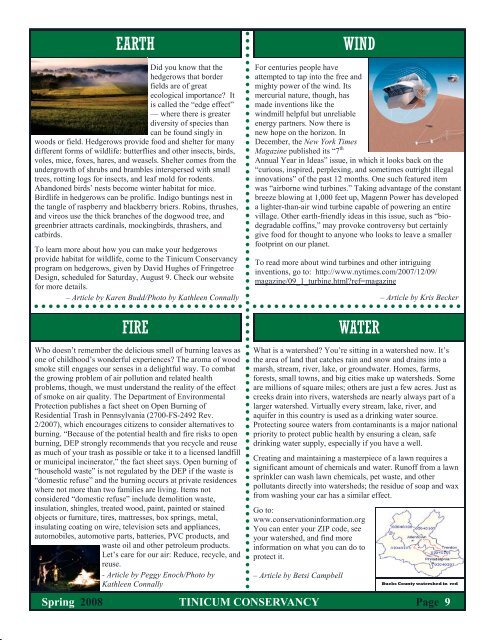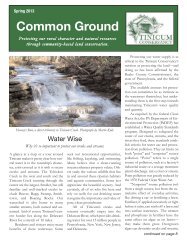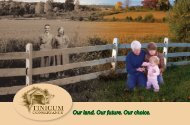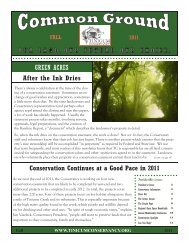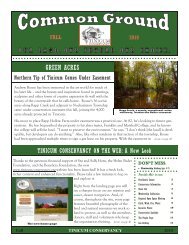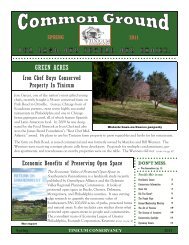Newsletter-Spring '08-FINAL to printer3-6-08 - Tinicum Conservancy
Newsletter-Spring '08-FINAL to printer3-6-08 - Tinicum Conservancy
Newsletter-Spring '08-FINAL to printer3-6-08 - Tinicum Conservancy
You also want an ePaper? Increase the reach of your titles
YUMPU automatically turns print PDFs into web optimized ePapers that Google loves.
EARTHDid you know that thehedgerows that borderfields are of greatecological importance? Itis called the “edge effect”— where there is greaterdiversity of species thancan be found singly inwoods or field. Hedgerows provide food and shelter for manydifferent forms of wildlife: butterflies and other insects, birds,voles, mice, foxes, hares, and weasels. Shelter comes from theundergrowth of shrubs and brambles interspersed with smalltrees, rotting logs for insects, and leaf mold for rodents.Abandoned birds’ nests become winter habitat for mice.Birdlife in hedgerows can be prolific. Indigo buntings nest inthe tangle of raspberry and blackberry briers. Robins, thrushes,and vireos use the thick branches of the dogwood tree, andgreenbrier attracts cardinals, mockingbirds, thrashers, andcatbirds.To learn more about how you can make your hedgerowsprovide habitat for wildlife, come <strong>to</strong> the <strong>Tinicum</strong> <strong>Conservancy</strong>program on hedgerows, given by David Hughes of FringetreeDesign, scheduled for Saturday, August 9. Check our websitefor more details.– Article by Karen Budd/Pho<strong>to</strong> by Kathleen ConnallyFIREWINDFor centuries people haveattempted <strong>to</strong> tap in<strong>to</strong> the free andmighty power of the wind. Itsmercurial nature, though, hasmade inventions like thewindmill helpful but unreliableenergy partners. Now there isnew hope on the horizon. InDecember, the New York TimesMagazine published its “7 thAnnual Year in Ideas” issue, in which it looks back on the“curious, inspired, perplexing, and sometimes outright illegalinnovations” of the past 12 months. One such featured itemwas “airborne wind turbines.” Taking advantage of the constantbreeze blowing at 1,000 feet up, Magenn Power has developeda lighter-than-air wind turbine capable of powering an entirevillage. Other earth-friendly ideas in this issue, such as “biodegradablecoffins,” may provoke controversy but certainlygive food for thought <strong>to</strong> anyone who looks <strong>to</strong> leave a smallerfootprint on our planet.To read more about wind turbines and other intriguinginventions, go <strong>to</strong>: http://www.nytimes.com/2007/12/09/magazine/09_1_turbine.html?ref=magazineWATER– Article by Kris BeckerWho doesn’t remember the delicious smell of burning leaves asone of childhood’s wonderful experiences? The aroma of woodsmoke still engages our senses in a delightful way. To combatthe growing problem of air pollution and related healthproblems, though, we must understand the reality of the effec<strong>to</strong>f smoke on air quality. The Department of EnvironmentalProtection publishes a fact sheet on Open Burning ofResidential Trash in Pennsylvania (2700-FS-2492 Rev.2/2007), which encourages citizens <strong>to</strong> consider alternatives <strong>to</strong>burning. “Because of the potential health and fire risks <strong>to</strong> openburning, DEP strongly recommends that you recycle and reuseas much of your trash as possible or take it <strong>to</strong> a licensed landfillor municipal incinera<strong>to</strong>r,” the fact sheet says. Open burning of“household waste” is not regulated by the DEP if the waste is“domestic refuse” and the burning occurs at private residenceswhere not more than two families are living. Items notconsidered “domestic refuse” include demolition waste,insulation, shingles, treated wood, paint, painted or stainedobjects or furniture, tires, mattresses, box springs, metal,insulating coating on wire, television sets and appliances,au<strong>to</strong>mobiles, au<strong>to</strong>motive parts, batteries, PVC products, andwaste oil and other petroleum products.Let’s care for our air: Reduce, recycle, andreuse.- Article by Peggy Enoch/Pho<strong>to</strong> byKathleen ConnallyWhat is a watershed? You’re sitting in a watershed now. It’sthe area of land that catches rain and snow and drains in<strong>to</strong> amarsh, stream, river, lake, or groundwater. Homes, farms,forests, small <strong>to</strong>wns, and big cities make up watersheds. Someare millions of square miles; others are just a few acres. Just ascreeks drain in<strong>to</strong> rivers, watersheds are nearly always part of alarger watershed. Virtually every stream, lake, river, andaquifer in this country is used as a drinking water source.Protecting source waters from contaminants is a major nationalpriority <strong>to</strong> protect public health by ensuring a clean, safedrinking water supply, especially if you have a well.Creating and maintaining a masterpiece of a lawn requires asignificant amount of chemicals and water. Runoff from a lawnsprinkler can wash lawn chemicals, pet waste, and otherpollutants directly in<strong>to</strong> watersheds; the residue of soap and waxfrom washing your car has a similar effect.Go <strong>to</strong>:www.conservationinformation.orgYou can enter your ZIP code, seeyour watershed, and find moreinformation on what you can do <strong>to</strong>protect it.– Article by Betsi CampbellBucks County watershed in red<strong>Spring</strong> 20<strong>08</strong> TINICUM CONSERVANCY Page 9


